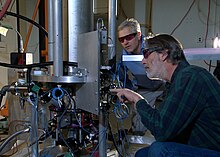Caesium standard
This article needs to be updated. The reason given is: it needs to reflect the 2019 redefinition of the SI base units, which came into effect on May 20, 2019. (January 2020) |

The caesium standard is a primary frequency standard in which the photon absorption by transitions between the two hyperfine ground states of caesium-133 atoms is used to control the output frequency. The first caesium clock was built by Louis Essen in 1955 at the National Physical Laboratory in the UK.[1] and promoted worldwide by Gernot M. R. Winkler of the United States Naval Observatory.
Caesium atomic clocks are the most accurate time and frequency standards, and serve as the primary standard for the definition of the second in the International System of Units (SI) (the modern form of the metric system). By definition, radiation produced by the transition between the two hyperfine ground states of caesium (in the absence of external influences such as the Earth's magnetic field) has a frequency, ΔνCs, of exactly 9192631770 Hz. That value was chosen so that the caesium second equalled, to the limit of human measuring ability in 1960 when it was adopted, the existing standard ephemeris second based on the Earth's orbit around the Sun.[2] Because no other measurement involving time had been as precise, the effect of the change was less than the experimental uncertainty of all existing measurements.
Technical details[]
The official definition of the second was first given by the BIPM at the 13th General Conference on Weights and Measures in 1967 as: "The second is the duration of 9192631770 periods of the radiation corresponding to the transition between the two hyperfine levels of the ground state of the caesium 133 atom." At its 1997 meeting the BIPM added to the previous definition the following specification: "This definition refers to a caesium atom at rest at a temperature of 0 K."[3]
The BIPM restated this definition in its 26th conference (2018), "The second is defined by taking the fixed numerical value of the caesium frequency ∆Cs, the unperturbed ground-state hyperfine transition frequency of the caesium 133 atom, to be 9 192 631 770 when expressed in the unit Hz, which is equal to s–1."[4]
The meaning of the preceding definition is as follows. The caesium atom has a ground state electron state with configuration [Xe] 6s1 and, consequently, atomic term symbol 2S1/2. This means that there is one unpaired electron and the total electron spin of the atom is 1/2. Moreover, the nucleus of caesium-133 has a nuclear spin equal to 7/2. The simultaneous presence of electron spin and nuclear spin leads, by a mechanism called hyperfine interaction, to a (small) splitting of all energy levels into two sub-levels. One of the sub-levels corresponds to the electron and nuclear spin being parallel (i.e., pointing in the same direction), leading to a total spin F equal to F = 7/2 + 1/2 = 4; the other sub-level corresponds to anti-parallel electron and nuclear spin (i.e., pointing in opposite directions), leading to a total spin F = 7/2 − 1/2 = 3. In the caesium atom it so happens that the sub-level lowest in energy is the one with F = 3, while the F = 4 sub-level lies energetically slightly above. When the atom is irradiated with electromagnetic radiation having an energy corresponding to the energetic difference between the two sub-levels the radiation is absorbed and the atom is excited, going from the F = 3 sub-level to the F = 4 one. After a small fraction of a second the atom will re-emit the radiation and return to its F = 3 ground state. From the definition of the second it follows that the radiation in question has a frequency of exactly 9.19263177 GHz, corresponding to a wavelength of about 3.26 cm and therefore belonging to the microwave range.
See also[]
References[]
- ^ L. Essen, J.V.L. Parry (1955). "An Atomic Standard of Frequency and Time Interval: A Caesium Resonator". Nature. 176 (4476): 280–282. Bibcode:1955Natur.176..280E. doi:10.1038/176280a0. S2CID 4191481.
- ^ Markowitz, W.; Hall, R.; Essen, L.; Parry, J. (1958). "Frequency of Cesium in Terms of Ephemeris Time". Physical Review Letters. 1 (3): 105. Bibcode:1958PhRvL...1..105M. doi:10.1103/PhysRevLett.1.105.
- ^ "Comité international des poids et mesures (CIPM): Proceedings of the Sessions of the 86th Meeting" (PDF) (in French and English). Paris: Bureau International des Poids et Mesures. 23–25 Sep 1997. p. 229. Archived from the original (PDF) on 4 December 2020. Retrieved 30 December 2019.
- ^ "Resolution 1 of the 26th CGPM" (in French and English). Paris: Bureau International des Poids et Mesures. 2018. pp. 472 of the official French publication. Archived from the original on 2021-02-04. Retrieved 2019-12-29.
 This article incorporates public domain material from the General Services Administration document: "Federal Standard 1037C". (in support of MIL-STD-188)
This article incorporates public domain material from the General Services Administration document: "Federal Standard 1037C". (in support of MIL-STD-188)
External links[]
| Wikimedia Commons has media related to Caesium clocks. |
- Electronics standards
- Atomic clocks
- Caesium
- Physics stubs